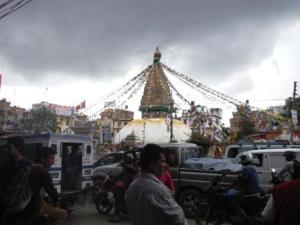It’s been awhile since I’ve written – we’ve shifted two countries since my last post. We spent about 3.5 weeks in Madurai, India with the Aravind Eye Center – an amazing place of efficiency and compassion and the largest eye center in the world. I was observing with their training and outreach divisions in preparation for our jump over to Africa. As of last Monday, we are Kumasi, Ghana at the Komfo Anokye Teaching Hospital (KATH) Eye Center…
We are always on the periphery. Living so transiently, it is hard to do anything but skim the surface. This is especially the case working and often living in a hospital setting as we did in Nepal and India. Kathmandu
allowed us to live closer to reality. We lived about a mile or so from the hospital and given our love of walking, the safety of the city, and its amazing sites, we learned the narrow alleyways and side streets. During our 4 weeks there, I loved the feeling of the city map connecting in my head, the chaos forming into logic. However in both far western Nepal and in Madurai, India where we spent time at the Aravind Eye Center, we lived within the hospital campus. A literal and figurative wall separated us from daily life with only all too brief chance to voyeur out and glimpse life.
We are learning to live on the periphery and negotiate this challenging precipice. It is far too easy to convince yourself that you belong in one realm over the other, to forget that you are straddling worlds, cultures, beliefs, values, to forget that only those that you claim as your own are real in that moment. It is far too easy to forget yourself and your role on the edge, to let yourself be convinced of your insignificance and to be lulled into a sense of false purpose holed up in your little world. I found this in Far Western Nepal. There I distanced myself even further from the world convincing myself of the “need” to complete one project, only to find myself too distracted, discontented and full of self-doubt to finish anything. Instead of throwing myself into my present surroundings, drinking in all I could, I hid myself, holed up with my computer and convinced myself this was productive. While the beauty of the place will stay with me, those memories fade overtime as do pictures. Regret will linger on. Engagement, friendship, and knowing that your weariness at the end of the day comes from an earnest attempt to connect –those feelings drive you forward and bring reality closer.
My spouse now struggles here in Ghana, with similar feelings of underutilization and a sense of uselessness. It is compounded by the extreme need we see around us and the lack of efficient systems in place to allow him to practice and work effectively as a clinician. We are learning how to support each other, to balance the ups and downs of our two unique souls within the space of our shared guest house room, and our shared experiences. Ghana feels more familiar to me, having worked so long in East Africa – other former British colonies. Despite the separation of thousands of miles, there are similarities of history and experience despite the vastly different cultures. We are too much on the periphery here, too separated from the local culture and people by circumstances and expectations (both ours and the teaching hospital where we are working). We stay at a guesthouse run by the hospital for its visiting doctors and nurses, and are currently living with 3 other Americans.
The hospital wants us to a car and driver they provide to walk the mile to and from the guesthouse. This we have politely declined, and use the time to walk and observe, though it is too short a walk to truly engage. This we are unsure of how best to do, and so far have been too exhausted by our attempts to process our daily work to do much of anything except head back and forth to the eye clinic.
Being an evaluator internationally is challenging since by definition I am to be the outsider yet offer recommendations and advice… there is so much weariness though in never understanding. Not knowing cultural difference places me as the ultimate outsider, often too ignorant to appreciate the complexities at work, and thus my recommendations I fear are ill-advised or laughable. There are also many things that simply just do not make sense. Here in Ghana I am focused much more on operational systems and helping the hospital use data in its decision making processes. A lot of time is spent crunching numbers, a lot of time observing patient flow, and also time spent waiting for someone. I sit writing this post now lying in wait for the eye clinic director in his clinic room so we can finalize a proposal. He has been in and seen several patients in my presence and left again, “We’ll meet in 5 minutes…” he says rushing out the door some 10 minutes ago…
Every experience builds on another, and to have courage to learn from past mistakes is a major focus now. Someone told us recently, “Manage expectations- that is the key to living here.” It is true for so much of life and work, both domestically and internationally. We learned so much from our time in Nepal and India, perhaps most importantly to be filled with compassion, for those around us and also with ourselves. It is so easy to forget, to look away, to be focused on the project instead of the life around it. Ghana is shaking us up and reminding us how much on the edge we are, and as we struggle forward to find our footing, we can only try to our best to follow a mentor’s advice to me, “Go out there and do some good…”





